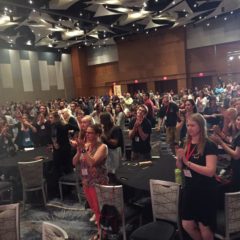For every completed book I post on Instagram, I add a new novel to my stack. For every workshop I attend, at least a handful of tweets and sixty minutes of happy hour discussion ensue. This is my summer vacay-on. An adios to the grading is a bienvenidos to the reflecting, thinking, and planning for next year. A typical teacher’s summer–whether we like it or not–follows the National Board cycle of plan, act, reflect.
Two weeks ago I found myself learning and reflecting in the mountains suffering from altitude sickness and allergy attacks. My husband, Nate Bowling, was invited to speak at the Aspen Ideas Festival. He slayed (recordings can be found here).
The Aspen Ideas Festival is known as a place where brilliant minds meet, theories clash, and plans are hatched. I had no idea how incredible it would be or how dumb I would feel. I definitely didn’t recognize Katie Couric sitting next to me. Even though I know and love Melissa Block from All Things Considered, I’d never seen a picture. I didn’t recognize David Brooks and Thomas Friedman when they walked past me. I tried not to geek out completely when I met Rabia Chaudry of the Undisclosed Podcast and Serial fame.
Here are some of the sessions I attended:
- The America Women Know
- Being Muslim and American in 2017
- Hate on the Rise–And What We Can Do to Stop It
- Guns And State Rights: A Loaded Weapon?
- Creative Tensions: The Responsibility of Identity
- When Color Blindness Renders Me Invisible to You
- Building American Talent (Making it in the US)
- Leadership Through Inspiration
- Deep Dive: Rural America
- On Being Latino In America
At first glance, my choices might look like a strange exhibition at the art museum. With a closer look, you’ll notice that each session is like an episode of an epic podcast series (think Serial or S-Town) working to form a complete story. Here’s what I imagine each episode to include.
Episode One: Who are we?
We live in a country comprised of different languages, cultures, values, and perspectives. Yet, as a nation, we struggle to find a sense of identity. Are we a Superpower? Are we the creators of the American Dream? Are we Big Brother? Are we the defender of democracy and justice in the world? Do we have a national language? Are we religious? Are we white or black or brown or multiracial?
We are all of those and none of the above. Because our identity is ever changing, ever evolving, we continuously wrestle with our sense of national identity. Voices press from all sides wanting us to be this or that, praising the merits of color blindness and telling us to ignore our differences.
At the Festival, Haris Tarin (Senior Policy Director for Homeland Security) shared a story about his father who emigrated from Afghanistan. His father always said, “I moved to this country because I would not be accepted for who I am [in Afghanistan]. I think my children will be able to find that acceptance [in America].” While this family found that acceptance, today many Americans can’t find a place to fit in and don’t feel a sense of belonging anywhere. Our culture affirms certain identities and rejects others.
Our students are bombarded by conflicting messages about their identities and place in our world. They bring whatever they’ve internalized into our classrooms and it’s our duty to address them.
Episode Two: Haters Gonna Hate
Yes, it’s official. Hate is on the rise. Say what you will about the reasons for that. Maybe it’s the election. Maybe it’s that we have more technology at our fingertips and therefore are able to document and report these occurrences. Maybe it’s because we’ve moved away from accepting the “kids will be kids” excuse for bullying and harassment and have consequently implemented Student Life departments to prevent and manage cases. Maybe we are more sensitive because we realize it’s not about being politically correct but about not being a jerk. We may be “better off” than we were in the 50s but we still have white supremacy driving the increasing acts of hate. We–especially those of us who are part of the dominate culture, language, or power structures–must stop ignoring this.
In particular, educators must learn how to shut down acts of hate in our schools by identifying symbols of hate and facilitating “table talk” about these issues. We have to stand up for the kids in our classrooms who are systematically pushed to the edges of society.
Episode Three: The Invisible Costs
Throughout the week, I thought about the young women in our schools who are looking at a future where they continue to be paid less than men and have yet to see themselves as presidents. I reflected on the thousands of Muslim children who are carrying the weight of a conflicted identity because we say that in America you can be both, and; however, these kids aren’t allowed that luxury. I wondered about the young Black men in my classroom who pursue their dreams but constantly worry about being stopped by the police for wearing a hoodie and carrying some Takis. I pondered the attacks on immigrants, the ease by which immigrants are targeted and fear of the “other” is whipped up.
Educators, we have to see our students. Start by dropping the assumptions. Examine the expectations we have for our students. Listen to what they share with us. Accept who they are and support them.
Episode Four: A New Hope
As Jonathan Greenblatt said, “The best antidote to hate is knowledge.”
We have the power to stop hate in this country, but we have to intentionally fight it through knowledge and education. Wherever you are, whatever you are blessed to be doing, you have a responsibility to do something with your platform. That might mean doing what Camille Jones, 2017 State Teacher of the Year does with her blog, Farmtable Teach or what teacher leaders are doing over at Corelaborate.
Of course we can’t do this alone but can as a community. Join a network such as #EduColor or create your own network of like-minded educators. We need to work together and collaborate. Even if we don’t agree 100% on everything we have to find a way to organize around the most important 75%. Our children cannot wait for us to stop bickering over nonsense.
Epilogue:
Okay, so maybe this is an extremely short season of your new favorite podcast, but you get the point. Over and over, speakers challenge the audience to see both the beauty and the pain, to challenge our fears, to share our stories, to get uncomfortable, and to grow.

 I should be reading
I should be reading 



 endent of Public Instruction, Chris Reykdal outlined a series of phases that addressed his
endent of Public Instruction, Chris Reykdal outlined a series of phases that addressed his  There’s a place on the Washington coast called Taholah. I’ve been there a few times on my bicycle, riding up Highway 109 from Ocean Shores. The scenery is staggering. There’s huge trees everywhere, a river on the north end of town and an ocean to the west.
There’s a place on the Washington coast called Taholah. I’ve been there a few times on my bicycle, riding up Highway 109 from Ocean Shores. The scenery is staggering. There’s huge trees everywhere, a river on the north end of town and an ocean to the west.